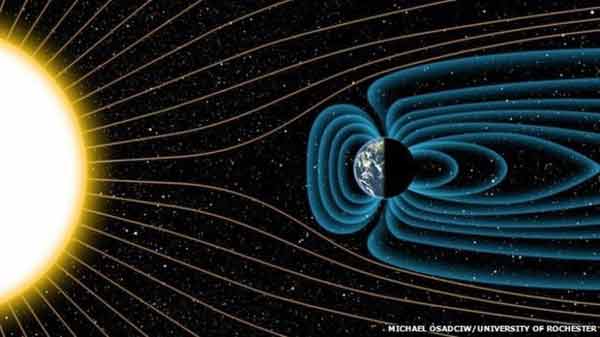
New York, US (BBN)-The Earth's magnetic field, which shields the atmosphere from harmful radiation, is at least four billion years old, according to scientists.
This is 550 million years older than it was previously believed to be, reports BBC.
Scientists at Rochester University in New York analysed crystals found in Western Australia.
Data on our planet's magnetic field was found to be preserved in ancient crystals embedded in rock formations in the region.
The findings have been published in the journal Science.
As the Sun slowly loses mass, it emits particles which have the potential to erode the Earth's atmosphere. The magnetic field protects Earth from these solar winds.
The research published in Science has overtaken the 2010 estimate of 3.45 billion years.
"Understanding how the magnetic field is generated is important because it's a fundamental property of the Earth. It sets it apart from other planets," Dr Jonathan Mound, from the School of Earth and Environment at the University of Leeds, explained to BBC News.
The Earth's magnetic field is generated because of the motion of molten iron in its outer core, referred to as a geodynamo. To work, heat must be regularly released, which is aided by plate tectonics.
The team collected rock samples from Jack Hills in Western Australia, an area that has been studied for many years.
The rock samples for the study were collected from Jack Hills, Australia.
"The spin in iron atoms align relative to the Earth's magnetic field, and preserve that information unless the material is heated above a property called the Curie temperature," Professor John Tarduno, a geophysicist at the University of Rochester and a leading expert on Earth's magnetic field, told BBC News.
"For magnetite this is 580C. When a mineral is heated to above its Curie temperature, it loses that information."
Thousands of tiny zircon crystals were separated by hand from the bulk rock, as magnetic separation techniques would have contaminated the samples.
An iron ion micro-probe was used to determine the age of the zircon. It detected lead and uranium, and radioactive decay enabled age determination.
The magnetisation was then determined with a magnetometer.
"It's a technological challenge to measure the magnetisation of zircons so we built a special magnetometer for these studies," Prof Tarduno explained, referring to the SQID (superconducting quantum interfering device), which unlocks the magnetic field record held in the zircons.
After the analysis is finished, only a few percent of the data collected pass the rigorous reliability tests, to ensure the calculated age is reliable.
"The event which formed the Moon means that we can never see what happened in the first 100 million years of Earth's life as the information was wiped out by that event," Prof Tarduno said.
"To get older data, we need to be sure that the zircons have been preserved and have not been reheated above their Curie temperature."
"Something that is important to establish for the future is whether the field has been continuously present for four billion years or if it died away and then a new field came back," Dr Mound commented.
The group is also working on samples from Zimbabwe, which are thought to hold zircons with an age of 3.8 billion years old.
BBN/SK/AD